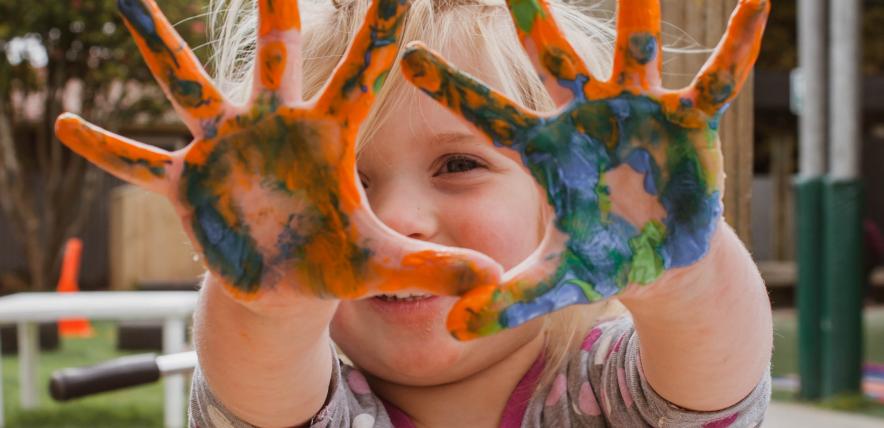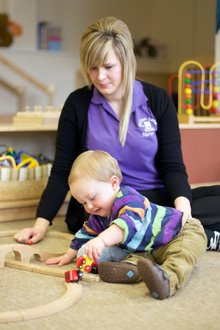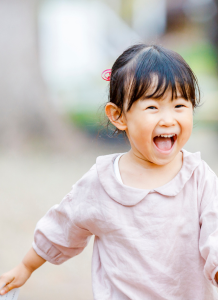By Nicky Sanford
Most parents can’t wait for the opportunity to hang their little one’s latest work of art on the fridge or cupboard door and, of course it’s wonderful to see the pictures that they create as they get older and more practiced.
But should we value the process of painting as much we do the product?
Exploring paint with all of their senses
In order to be able to create pictures and develop specific ideas with paint children need to have plenty of opportunities to explore how it behaves, how it can be used, how colours can be mixed and how paint changes as it dries.
It’s important for children to use all of their senses to explore paint and feel comfortable with its properties.
Here are some ideas to try…
Sitting in paint
Even the youngest baby may enjoy sitting in a shallow tray of paint. Most water based paints are non-toxic and safe to use with babies so there is little worry about painty fingers going into tiny mouths.
How: Sitting on a large sheet of paper or crawling through blobs of paint spread along an old roll of wallpaper.
Why: Not only can your little one experience the feel of the paint on their hands/arms or feet/legs they may also begin to show an interest in the marks they are creating and leaving behind them.
Painting on and with their hands
As children develop further, their creative explorations may extend to painting on or with their hands (often accompanied by the joy of washing them afterwards!) It can be a very calming experience to smear and mix paint with your fingers, often then travelling right up to the elbow or beyond! Providing children with the opportunity to explore paint with their hands introduces another level of sensory exploration.
How: Allow children to manipulate the paint with their fingers, and discover the marks that they can make with their hands. Finger or hand/feet prints are a lovely base for creating other types of picture crafts, flowers, animals or birds. With a little imagination the body parts can be turned into just about anything. However, please consider the involvement that your little one has in this process; they are not getting much from the experience if their hands are merely pressed onto a piece of paper, allow them to be active in this and see what marks they can make independently.
Why: Adding the interest of their own hands or feet, will involve children in counting and comparing sizes. They can also take pride in being involved in the creations that follow as their basic prints become Rudolph, a bunch of flowers, or an alien.
Painting the table
With some pre-agreed rules and plenty of preparation, allowing your little one to paint directly onto the table — covered in a plastic tablecloth or clingfilm first — gives an exciting new dimension to painting and the processes that can be explored. Be warned though — this can get very messy!
How: With plenty of paint applied, use fingers, spoon handles, forks or cotton buds to create patterns and designs that can then be lifted as a print by placing a sheet of paper on top and pressing down.
Why: This provides another way to explore mark-making and can also build up the finger muscles and early writing skills. Taking prints can allow you to discuss the lines and marks that have been created — plus the results make fantastic wrapping paper!
Painting boxes
Painting on large cardboard boxes is a lovely outdoor activity. With the results becoming train engines, castles, shops, a fire engine or a car — the possibilities are endless.
How: Move outside and use a big brush or decorator’s roller with whole arm movements to help develop gross motor skills.
Why: Working the arm and shoulder muscles are important for providing the support for the hand and finger actions necessary for handwriting later on.
Painting on an easel
Painting on paper pinned to a wall or easel provides a different perspective than paper prepared on a flat surface so giving opportunities to do both is important for children to explore painting as fully as possible.
The importance of the process
As children paint or draw it’s important to recognise the thought processes that are taking place.
The stages of using paint can be considered quite separately:
- Mixing and the sensory explorations
- Making marks and movements with the paint
- The emergence of recognisable shapes and enclosures
- Producing a picture and then deciding what it is
- Having a pre-thought idea about what they want to paint, the colours they will use and considering how they will go about it.
But what about the mess?
Understandably the idea of painting can be off-putting for some parents due to the potential mess involved!
So here are some ideas for keeping clean(er!):
- Use painting ‘pens’ rather than pots of paint
- Paint outside, leaving paintings to dry in the sun
- Prepare the area beforehand making sure tables and floorings are well covered
- Use old clothes (or no clothes!) that can be easily removed afterwards
- Keep a bowl of water and an old flannel nearby for a quick and easy cleanup before any surfaces are touched on the way to the sink!
A picture paints a thousand words
Because paint is fluid and changeable, what children paint is often changeable too. What starts out as one thing may well end up as something completely different, or in fact nothing specific at all.
Children don’t see painting as a ‘snaphot photo’ but as a story, it can evolve and develop. Watching as they paint can tell you a lot about what they are thinking. It can be so revealing to ask “tell me about your painting” as this gives the opportunity for your little one to talk about what they see, what has already been painted and what might happen next. Try and avoid asking specifically “what have you painted?” as your little one might not have thought that far ahead, but in fact has been enjoying the process of exploring the paint. In these cases, you can talk together about the colours, the texture of the paint, or the marks that they have made – rather than focussing on an ‘end product’ as such.
Don’t forget to date each painting attempt — or even frame it!
Presenting lots of artwork over time will tell a story of its own.
Updated in August 2024







